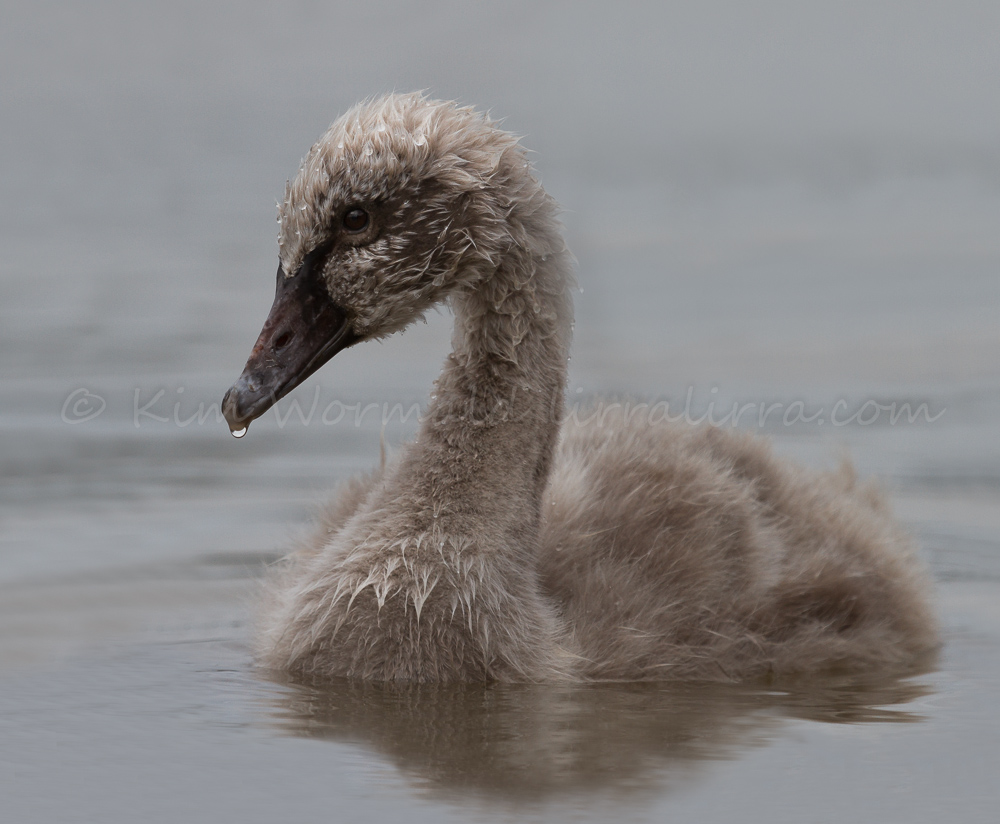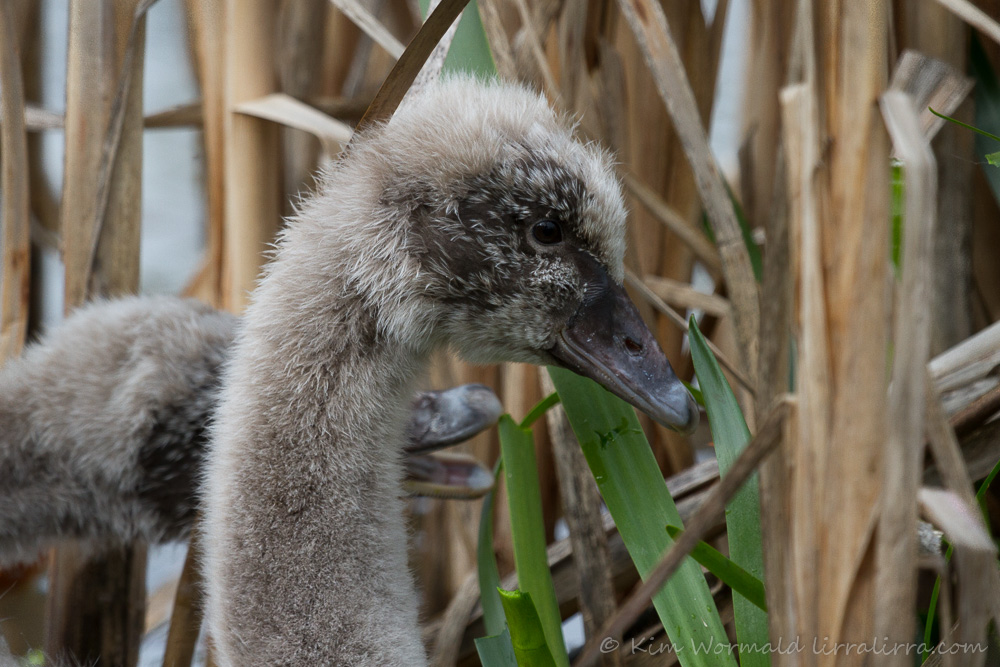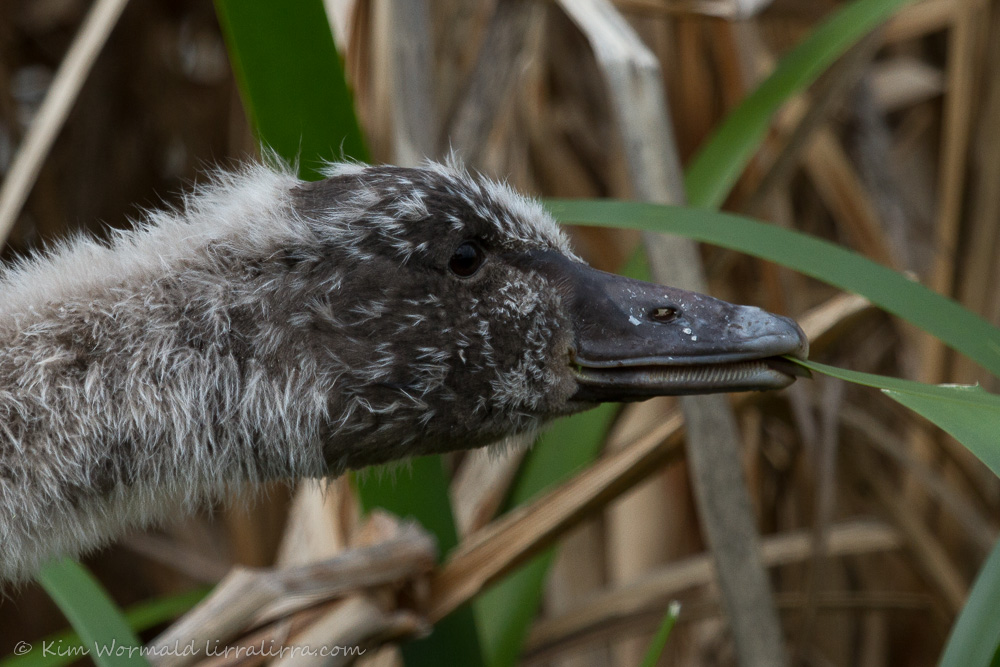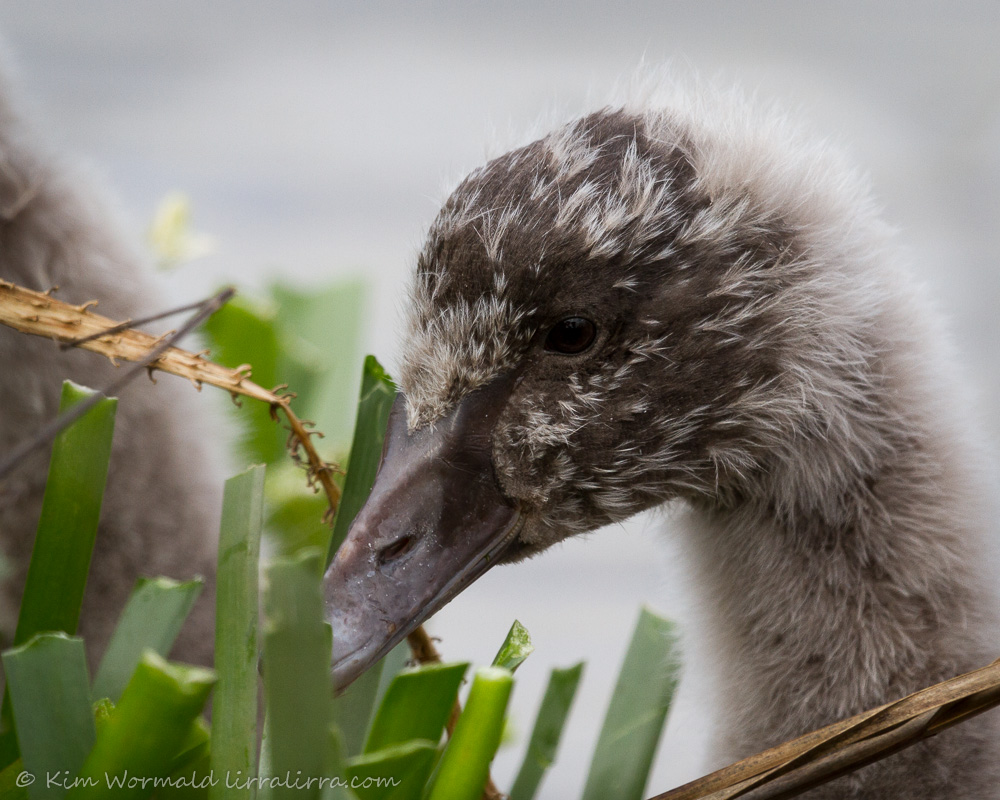It’s July, the middle of the Australian winter, and there in the wetlands are 5 bonny cygnets looking as though they hatched on or around Winter solstice. Black Swans can raise a clutch at any time of year, particularly after suitably heavy rainfall, but to me cygnets herald springtime and that’s a lovely thought when your toes are tired of being cold.
 Black Swan (Cygnus atratus) – cygnet
Black Swan (Cygnus atratus) – cygnet
Canon 7D, 100-400mm L IS USM, 1/500, f/5.6, ISO 160, 340mm
Oh my, the cygnet above made my heart go pitter-pat. It has a tufty look that is very endearing, along with the gentle curve of its neck and the way it is beaded with drops of water.
 Black Swan (Cygnus atratus) – cygnet
Black Swan (Cygnus atratus) – cygnet
Canon 7D, 100-400mm L IS USM, 1/500, f/5.6, ISO 160, 340mm
I liked the cygnet so much that I’ve included a shot that I took two frames later when the water droplet on its bill began to fall. I took a burst of three shots on high-speed continuous shooting which is supposed to have a rate of 8 frames per second. The two images above are the first and third in the series and the data says all three were taken at precisely the same time, down to the hundredth of a second. Now that’s a bit puzzling.
 Black Swan (Cygnus atratus) – cygnet
Black Swan (Cygnus atratus) – cygnet
Canon 7D, 100-400mm L IS USM, 1/500, f/5.6, ISO 320, 360mm
The cygnets were shepherded to the reeds by their watchful parents where they began grazing. I was focussing on the cygnet in the front as it peeked at the reeds. Its movements were so quick that it was hard to get the shot I was after but I was trying for it when the cygnet in the back darted into the frame.
 Black Swan (Cygnus atratus) – cygnet
Black Swan (Cygnus atratus) – cygnet
Canon 7D, 100-400mm L IS USM, 1/500, f/5.6, ISO 250, 340mm
This is a different cygnet; each one has an individual pattern of tufts as they lose their downy fluff. At last I got the shot I was after. This little one darted towards a reed and tore the end from it, the tiny pointed tip of the reed can just be seen at the base of its bill. If you’re looking that closely you will also be able to see its tongue peeking out and the tooth-like serrations that swans, and some other species, use to strain water when they are feeding on aquatic vegetation.
 Black Swan (Cygnus atratus) – cygnet
Black Swan (Cygnus atratus) – cygnet
Canon 7D, 100-400mm L IS USM, 1/500, f/5.6, ISO 400, 400mm
This reedy area is clearly a favourite place to dine as all of the reeds in this clump had been grazed.
 Black Swan (Cygnus atratus) – cygnet
Black Swan (Cygnus atratus) – cygnet
Canon 7D, 100-400mm L IS USM, 1/500, f/5.6, ISO 160, 320mm
A little more diffused light settled on the scene for a moment which brightened the catchlight in this cygnet’s eye as it glanced towards the camera. What a comical expression, so different from the graceful pose in the first two images.
I thoroughly enjoyed seeing these winter babies and am grateful to the new friend who kindly introduced me to some of her favourite places.
In August of last year I was lucky to see swans nesting and to photograph what I believe was the first time their cygnets took to the water. The images from that nest can be seen by visiting Spring is in the air and Cygnets on mum’s back.
Happy birding, Kim
NB It is now possible to receive a weekly email letting you know that lirralirra has been updated – just add your address to the ‘Subscribe to email’ box above right.
Also, I recently added a Facebook ‘like’ button. Thank you to all ‘likers’ – I like you too!

Kim, these are absolutely adorable and so well photographed! I love the tiny falling droplet of water, their fluffy appearance and your commentary too.
Thank you Mia, I felt privileged to spend time with the cygnets and am so pleased that you enjoyed the images and commentary.
Beautiful shots of such delicate and serene little babies! i love them!
I love the words you use to describe the cygnets and I’m glad the images captured that feeling, thank you.
Beautiful photographs. I can’t pick between them at all. 🙂
That’s lovely, thank you.
Gorgeous shots! The cygnets are adorable.
I’m so glad you liked the shots, thank you for commenting 🙂
Very sweet little birds
I totally agree!
ohhh how it s cute =)))
nice close up kim, a pleasure to watch 😉
thanks, and happy birding 😀
see you soon
Thanks for your comments Eric, it’s funny that we’re both seeing fledglings at the same time in different hemispheres, happy kestrelling 🙂
Hello Kim,
It’s a beautiful bird, and I never saw boney saw !!!! I’m very happy, thank’s a lot !
We can be cold for them.
Bye
Your comment made me smile! It’s lovely that you’re happy and yes, you’re right, we can definitely be cold for them 🙂
Kim, awesome shots of the cygnets. They are adorable, I love the droplet shot. And the closeups are amazing. Have a great weekend and happy birding!
I’m glad you liked the images Eileen, thanks for letting me know your favourites. You have a great weekend too!
Hello Kim,
Delightful to see the gray babies – I was unaware about the serrated tongue and I work in a Wetland! always something knew to learn and pass on to our visitors. The Black Swans at the Tamar Island Wetland in northern Tasmania are courting vigorously so breeding and building nests should not be far away. Many of my volunteers are excellent photographers and it would be great to send you a pic of our gray babies.
Best wishes
alison
Hi Alison, how lovely to hear about your pending gray babies, I’d love to see pics of them! It’s the inside of the bill that is serrated rather than the tongue itself, I’d better make that clearer in the text. I’m off to google the Tamar Island Wetland, sounds like another place to put on my wish list. Thank you so much for your comments.
Just beautiful Kim, the cygnets are so delicate, love the little droplet of water just leaving the beak.
Your colours are coming up so natural.
There is something delightful about cygnets and the droplet seemed to add something to the magic. That’s good about the colours, I like birds to look natural. Thanks for your comments, much appreciated.